
UNESCO World Heritage Sites in Southeast Asia are usually among the most popular destinations for tourists when visiting the region. Join Asia King Travel and uncover the cultural treasures that represent the enduring spirit of Southeast Asian civilizations, which have lasted for centuries.
Besides popular cities like Hanoi and Ho Chi Minh City, Hue is also a top destination in Vietnam with numerous historical attractions. Among these, the Complex of Hue Monuments is the most popular, known as a real indication of the splendor of the Nguyen Dynasty - the last feudal dynasty of this country.
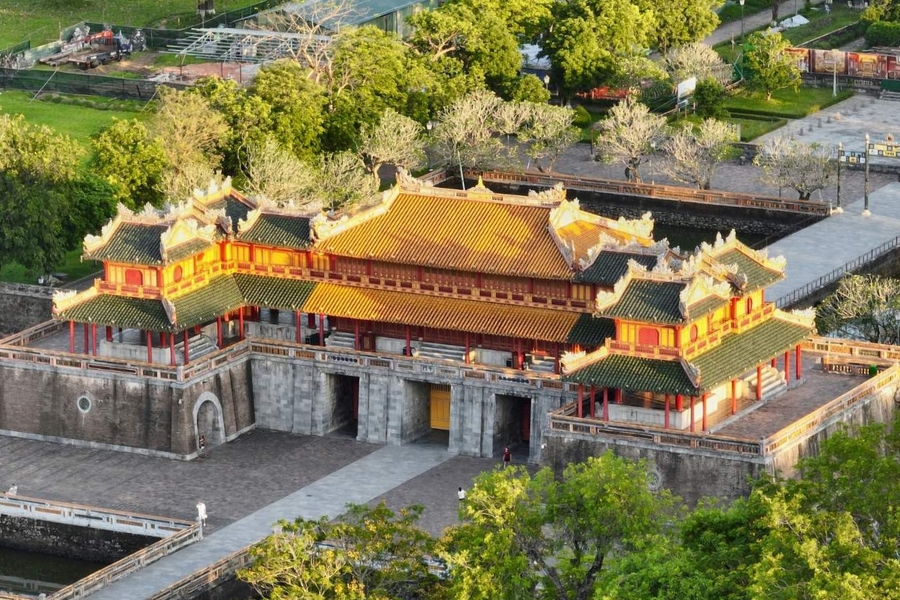
The Complex of Hue Monuments seen from above
There are three main sections in the site: Kinh Thanh (the Citadel), Hoang Thanh (the Imperial City), and Tu Cam Thanh (Purple Forbidden City), along with associated monuments outside, including the tombs of the emperors, temples, pagodas, and other spiritual sites. They are arranged within the natural setting of the site, as well as aligned cosmologically, creating a well-ordered architectural overall.
The complex bears the mark of traditional architectural art, delicately blending with the natural landscape through a system of palaces, temples, mausoleums and ancient walls. Each detail tells the story and lets visitors explore the eternal beauty of the nation's culture and history.
In addition, this is also a spiritual symbol of Vietnam, especially in the 19th century. It's a unique blend of Buddhism and Confucianism, creating a distinct religious and philosophical ideology. Therefore, in 1993, UNESCO recognized the Complex of Hue Monuments as a World Cultural Heritage.
The Angkor Complex is one of the largest wonders and among the most iconic historical places to visit in Southeast Asia, recognized by UNESCO as a World Heritage Site in 1992. It is located in the northwest of Tonle Sap Lake, Siem Reap Province, Cambodia, and was the ancient capital of the Khmer Empire from the 9th to the 15th century.
The entire complex is a mix of historical, cultural, and religious monuments, spanning over 400 square kilometers. These are stone architectural works in the form of temple-mountains found in Hinduism and Buddhism.
Characterized by ancient Khmer art, the entire architectural complex, from the overall large towers to the detailed decorative details, has a natural and lively look. There are five major temples in the Angkor complex, and the two most famous are Angkor Wat and Angkor Thom.
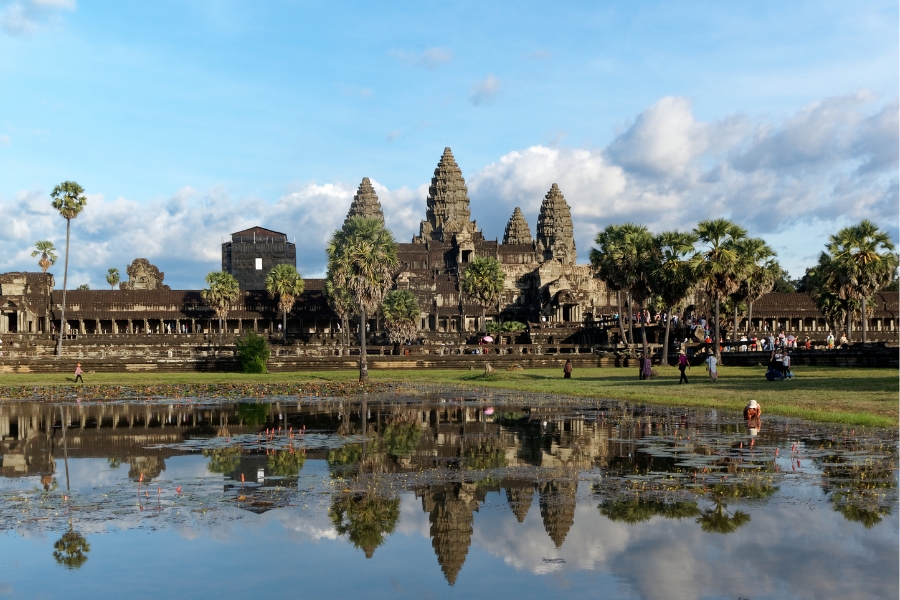
Angkor Wat is the most well-known temple in the Angkor complex
Many of the buildings are surrounded by moats that look like the ocean surrounding the earth and thereby create “the model of cosmic world”. The moats used to be an extensive irrigation system developed over several dynasties based on large reservoirs. This water system had supported the daily life of the people in the area and also helped create the economic infrastructure of the capital city of Angkor.
Located 85 kilometers north of Bangkok and surrounded by three rivers, Ayutthaya is one of the popular tourist destinations in Thailand with impressive historical relics. The city was the capital of the Kingdom of Siam for over 400 years, from the mid-14th century until it was razed by the Burmese in 1767. The ruins were then carefully restored, forming the Ayutthaya Historical Park, which was designated a UNESCO World Heritage Site.

The Ayutthaya Historical Park consists of unique buildings and numerous Buddha statues
Similar to Angkor Wat, the architectural works in Ayutthaya Historical Park are influenced by the Khmer style. These can be seen through temples and towers with sophisticated decorations. In addition, you can see many Buddha statues in different shapes and sizes. Among them, the Buddha's head embedded in the roots of a tree at Wat Mahathat is the most impressive, also a symbol of the longevity of Buddhism between time and nature.
The park consists of numerous temples, and every one of them is worth visiting. Usually, it takes half a day to fully experience the park. If you are not pressed for time, it is better to hire a tuk-tuk or rent a bike, so that you can get around every corner of the sites on your own.
Unlike the tourist places in Southeast Asia that are mostly traditional, George Town was created based on Western culture. It was founded in 1786 on the island of Penang, just off the west coast of Malaysia and a few hours north of Kuala Lumpur.
The town used to be the busiest seaport on the Sino-Indian trade route, and thanks to this, now it has a perfect blend from countries like India, China and Europe, creating a diverse mix of ethnicities and religions.
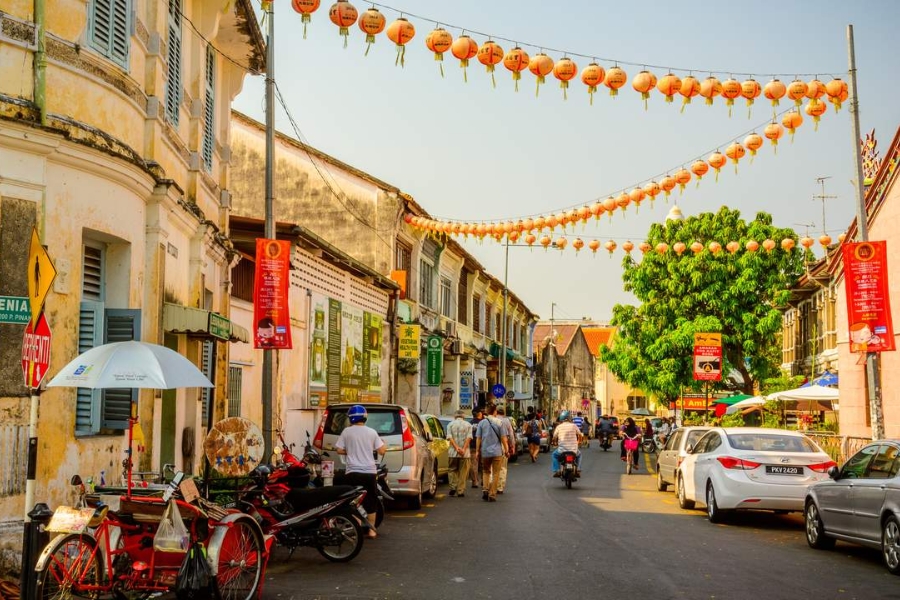
George Town has a perfect blend of many countries
When coming to the town, visitors can go and see plenty of buildings that are a fusion of various cultures. The Penang Peranakan Mansion (or the Green Mansion), the Blue Mansion and Khoo Kongsi are among the most attractive destinations. They are pretty photogenic, so bring your camera there and be ready to capture some nice pictures.
George Town is also called a "Street Art Museum", as there is a series of colorful 3D murals and steel sculptures. The town is like an open-air gallery, attracting visitors from all over the world. These murals are not only aesthetically beautiful but also carry meaningful messages from the locals.
You may like: Wonderful Journey in Malaysia tour 12 Days
Moving to Indonesia, Borobudur is a unique religious wonder that you cannot miss. It is the largest Buddhist temple in the world located in central Java Island. In Indonesian, Borobudur means “Buddhist temple on the hill”. This is because when looking from a distance, the temple looks like a hill or a pyramid with Buddha statues and impressive stupas emerging in the middle of a fertile plain, surrounded by mountains and forests.
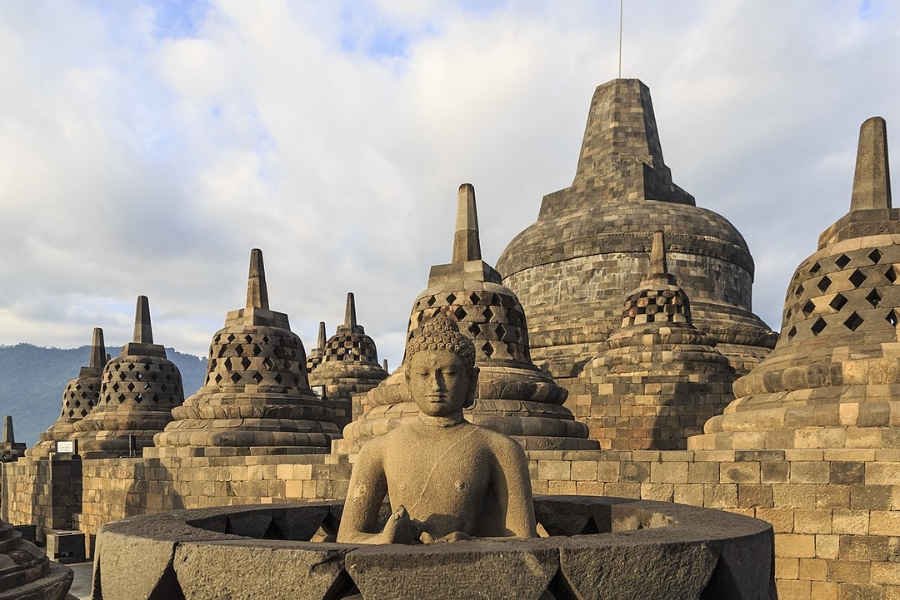
Borobudur is the largest Buddhist temple in the world
The temple was built in the 9th century in a unique Javanese architecture, combining indigenous and Indian cultures. The temple consists of nine floors and is topped by a circular roof, all concentric with a giant Buddha stupa in the center. The special thing about Borobudur is that it is made of 300,000 gray volcanic stones, tightly linked together without the need for cement or any adhesive material.
Initially, the temple was used as a Buddhist sanctuary between the 10th and 15th centuries, after which it was abandoned. It was then rediscovered in the 19th century and restored in the 20th century, then recognized as a UNESCO World Heritage Site in 1991. Today, Borobudur is an important site for Buddhism and attracts many tourists to Indonesia.
Not being so flashy, the ancient capital of Luang Prabang is like an old book covered in dust. The more you open it, the more beautiful it becomes.
Luang Prabang is situated in northern Laos, on a peninsula formed by the confluence of the Mekong and Nam Khan rivers. In the past, Luang Prabang was the capital of the Lan Xang Kingdom. The attraction of Luang Prabang comes from its rich historical and cultural heritage, as well as its quiet and peaceful beauty, which is ideal for slow travel in Southeast Asia.
The mountain ranges surround the town, especially Phou Thao and Phou Nang, giving Luang Prabang a cool green color, which is even more vivid in summer. The ancient streets and the pretty little houses with classic French architecture also contribute to creating a beautiful and romantic picture.
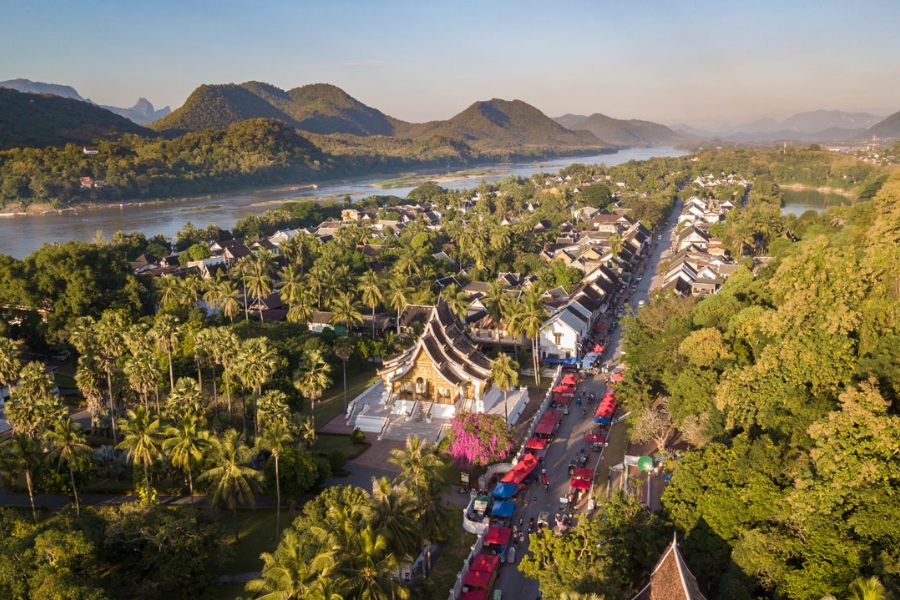
Luang Prabang has a vivid green colour, especially in summer
Visiting Luang Prabang is a journey that takes you back to the most beautiful days of this land. Walking through the ancient stone streets, you will be amazed by the beauty of the pagodas, temples and traditional houses. Immersing yourself in nature would also be a refreshing experience, as there are many interesting natural landscapes in this town. Most visitors said they felt their souls lighten as if they had just put aside a breath of hurried life.
Not only recognized by UNESCO as a World Heritage Site in 1995, Luang Prabang was also included in the list of 50 most attractive small towns in the world in 2023 by American travel magazine CN Traveller, offering a serene and relaxing experience to everyone.
Many UNESCO-listed Heritage Sites in Southeast Asia are well-known for preserving the region's rich cultural heritage, including history, culture, and spirituality. Asia King Travel offers a variety of tours in the region, so that you can explore these treasures with local insight and authentic experiences along the way. If you are interested, feel free to reach out to us.
You may like: Laos Vietnam Thailand Tour 23 Days: A Remarkable Journey